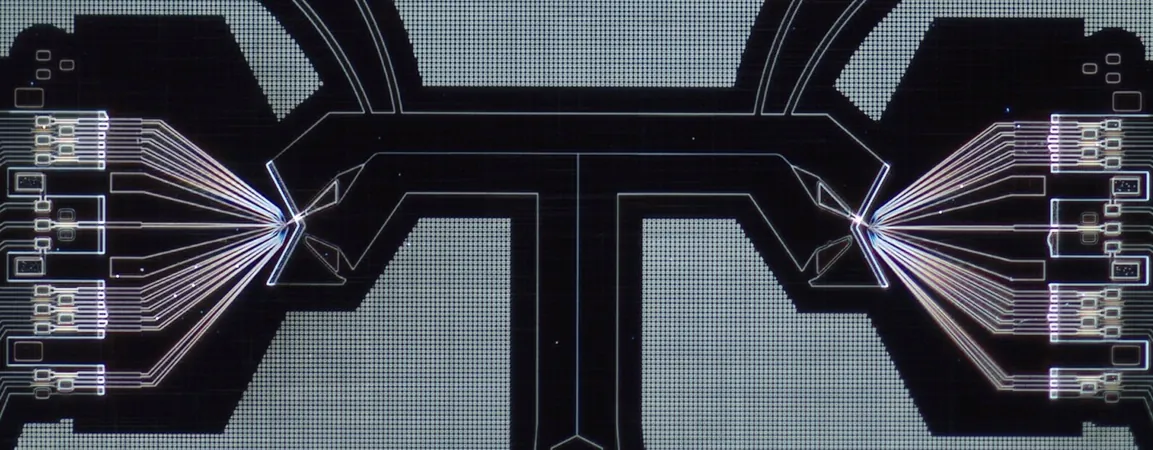
Groundbreaking Discovery: Long-Distance Quantum Spin Qubits Show Promise for Future Quantum Computing
2025-01-07
Author: Daniel
Introduction
Quantum computing is set to revolutionize the technology landscape, potentially surpassing classical computing in efficiency for complex optimization and data processing tasks. However, the road to large-scale, high-performance quantum computers has been paved with challenges, particularly in establishing controlled interactions between qubits, the core units of information in quantum systems.
Challenges with Distant Qubits
Maintaining consistent interactions among distant semiconductor qubits—while simultaneously controlling those interactions—has been a formidable challenge for researchers. Resolving this issue could significantly enhance the capabilities of quantum computers, enabling them to address more sophisticated problems in various fields, including cryptography, materials science, and artificial intelligence.
The Pioneering Study
A pioneering study from Delft University of Technology (TU Delft) has made significant strides in overcoming this barrier. The researchers have published their findings in Nature Physics, providing evidence of coherent interactions between two electron spin qubits separated by a distance of 250 micrometers. This new approach could fundamentally transform how qubit systems are designed and scaled in quantum computing.
Significance of the Achievement
According to Lieven Vandersypen, the senior author of the study, this achievement marks a significant milestone in quantum information processing. "Electron spins in semiconductor quantum dots are showing great promise for quantum information processing," Vandersypen stated. Historically, the common two-qubit gate exchange interaction has required qubits to be placed extremely close—just 100 nanometers apart. The team's breakthrough in realizing coherent interactions over much larger distances has long been a major goal in the quantum community.
Innovative Research Methodology
The innovative research builds on previous advancements in quantum computing, employing a clever combination of on-chip networks that integrate multiple qubit modules. These modules can conduct local quantum operations while enabling distant qubits to interact through long-range coupling mechanisms.
Experimental Setup and Results
In their experiment, the researchers constructed a system with two semiconductor spin qubits located 250 micrometers apart on the same chip, effectively demonstrating their coherent interaction. This was made possible through a superconducting resonator that acted as a mediator for the indirect interaction between the two spins.
Observations and Implications
Vandersypen elaborated, "Each spin is confined within an electrostatically defined double quantum dot, and they interact through virtual photons mediated by the on-chip superconducting resonator." By initializing one qubit into the ground state and the other into the excited state, the researchers successfully enabled a transfer of quantum states between the two qubits. As one qubit transitioned between states, the other followed suit, showcasing the potential to develop complex quantum logic operations involving distant spins.
Future Directions
"After conducting various spectroscopic measurements focused on coherent spin-photon interactions, we have, for the first time, observed time-domain oscillations," Vandersypen remarked. This observation is critical as it lays the groundwork for implementing quantum logic with remote spins and, consequently, the development of extensive on-chip networks of spin qubit registers.
Conclusion
The implications of this study are huge, suggesting that superconducting resonators may play a crucial role in fostering coherent interactions among distant spin qubits. The research team envisions that this approach will amplify the scalability of on-chip spin qubit networks, ultimately leading to the advent of superior quantum computers.
Looking Ahead
Looking ahead, Vandersypen expressed excitement about future research directions: "Having successfully observed time-domain oscillations between two spins, we aim to explore interactions between each spin and real photons within the resonator, which could manifest as vacuum Rabi oscillations. Our ultimate goal is to create robust networks of qubit registers."
As the field of quantum computing continues to evolve, this groundbreaking research from TU Delft represents a significant leap forward, promising a future where advanced quantum computers are capable of solving problems previously deemed unsolvable. The world watches closely as these scientists pave the way for this transformative technology.
 Brasil (PT)
Brasil (PT)
 Canada (EN)
Canada (EN)
 Chile (ES)
Chile (ES)
 Česko (CS)
Česko (CS)
 대한민국 (KO)
대한민국 (KO)
 España (ES)
España (ES)
 France (FR)
France (FR)
 Hong Kong (EN)
Hong Kong (EN)
 Italia (IT)
Italia (IT)
 日本 (JA)
日本 (JA)
 Magyarország (HU)
Magyarország (HU)
 Norge (NO)
Norge (NO)
 Polska (PL)
Polska (PL)
 Schweiz (DE)
Schweiz (DE)
 Singapore (EN)
Singapore (EN)
 Sverige (SV)
Sverige (SV)
 Suomi (FI)
Suomi (FI)
 Türkiye (TR)
Türkiye (TR)
 الإمارات العربية المتحدة (AR)
الإمارات العربية المتحدة (AR)